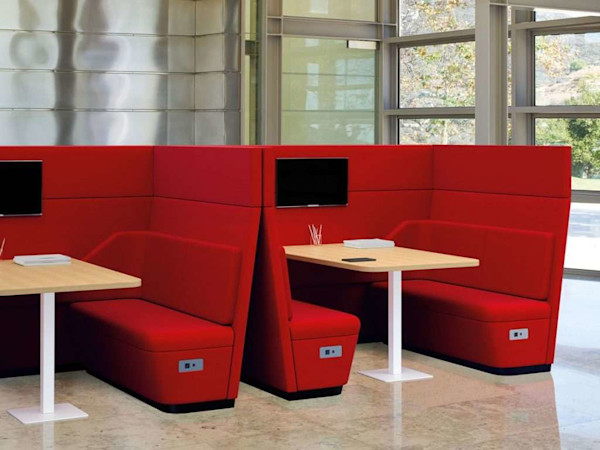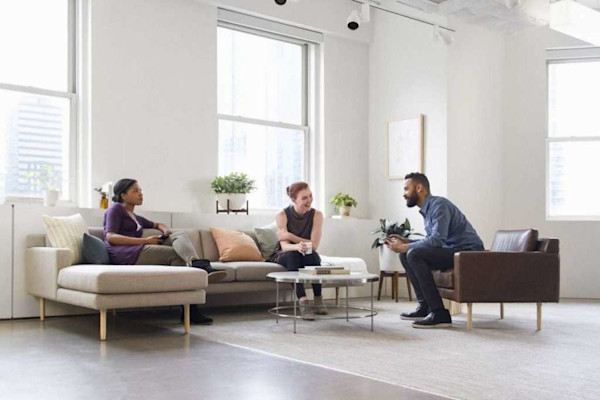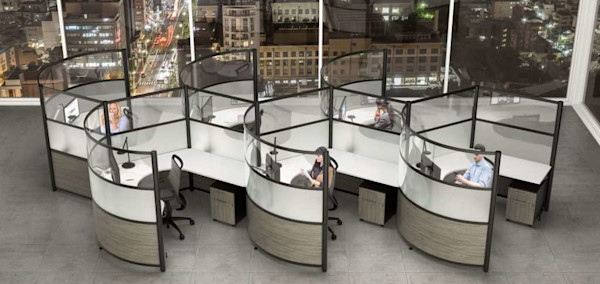Post-COVID Office Layout and the Hybrid Workforce

The future of the workplace continues to change as organizations have adapted to the long-term effects of the pandemic. What is certain is that hybrid work is here to stay, and employees are placing a high priority on comfort and flexibility. To welcome our team back to work, the Post-COVID office layout needs to adapt just as quickly.
Planning For Your Post-COVID Office

Any office design shifts post-pandemic should prioritize employee wellness.
If gathering data through the use of GIS technology about how your teams work isn't feasible, there are still great alternatives to making strategic office design plans. First, talk with your team. If you want to know what your employees want in an office layout, the best thing to do is ask. There may be barriers to productivity that you can't see or ways your team wants to collaborate that aren't currently available. Second, take a step back and observe. Is the break room a place where employees go to brainstorm? Are employees having to wear headphones to block out noise during zoom calls? Are conferences rooms in high demand for collaboration sessions? No matter how you go about it, gathering data before you begin your Post-COVID office layout changes, is the first place to start. And including these common elements will ensure that you are planning for the future of work.
Support Culture, Collaboration, and Connection

Culture, collaboration, and connection. These 3 C's can make all the difference when it comes to creating an office environment that your employees want to be in. The office must become a resource where employees want to go. Here they can find things that they can't get at home. Create an atmosphere that drives productivity, fuels innovation, inspires creativity, and encourages community. To create this environment, there are four work models that need to be considered: focus, collaboration, learning, and socializing. In a hybrid workforce, with individuals coming to the office only part of the time, the need for focused work is often overlooked. While many workers do use their office time for collaboration and connection, 45% of their time is still spent in focused work. Incorporating acoustic furniture into open office areas can help ensure that these needs are still met.
To welcome our team back to work, the Post-COVID office layout needs to adapt.
Any Post-COVID office layout must include increased technology features in any collaborative or social areas. This may include more screens, in meeting areas to include remote team members. Or increased plugs, ports, and laptop tables to accommodate workers as they transition between home and the office. The bottom line is each space should be created with productivity in mind. What would make this space more conducive to getting work done and collaborating with team members? One of the biggest gaps many organizations faced as they adapted to working from home was training new team members. When reflecting on great training experiences, many people use phrases like, "hands-on," "experience-based," "personal" and "inquiry-based". These terms are hard to fulfill when working from home. Any office design in our new environment needs to include areas that are conducive to training and learning. 20% of new hires leave within their first 45 days. Prioritizing training and creating an atmosphere conducive to learning can help.
Health, Well-being and the Hybrid Workforce

72% employees are currently unhappy with the level of flexibility they currently have at work.
Creating wellness plans at work must include mental health. From burnout to isolation to anxiety and overwhelm, many employees struggled to adjust to working from home. And as we return to the office, the focus on mental health and wellness needs to continue. The shared grief and loss that was faced by all during the pandemic has opened the doors for real authentic conversations about mental health. Creating psychological safety in the workplace can help ensure these conversations continue.
Flexible Post-COVID Office Design

Flexible Schedules and Hybrid Work
In many industries hybrid work is now the predominant business model. And globally, it is overwhelming the model that employees want. But despite our lived experiences over the last two years, a majority of companies are not prepared to meet the demands of a flexible working environment. Workplace flexibility goes beyond where they are working but perhaps more importantly to when they are working. In a recent report from Future Forum 95% of employees wanted flexible hours, while 78% wanted the flexibility to work from home. According to Future Forum Vice President Sheela Subramanian “It really needs to be a shift from presenteeism and activity tracking to actually understanding the results that people are driving and the value that they’re creating,” This desire for flexibility extends to all areas of where, when and how the work gets done and is a high priority for employees. In fact, 72% are currently unhappy with the level of flexibility they currently have at work and would likely leave within a year. The time is now to change your mindset about work and adapt your post-Covid office to include increased flexibility and focus on the needs of your team. Create the ideal Post-COVID office layout for your hybrid workforce with StrongProject.com.
The Hybrid Workplace: What You Need To Know For The Future Of Work
5 Modern Commercial Furniture Layouts for the Hybrid Office Redefining Workspaces: The Comprehensive Guide to Hybrid Workplace Design



